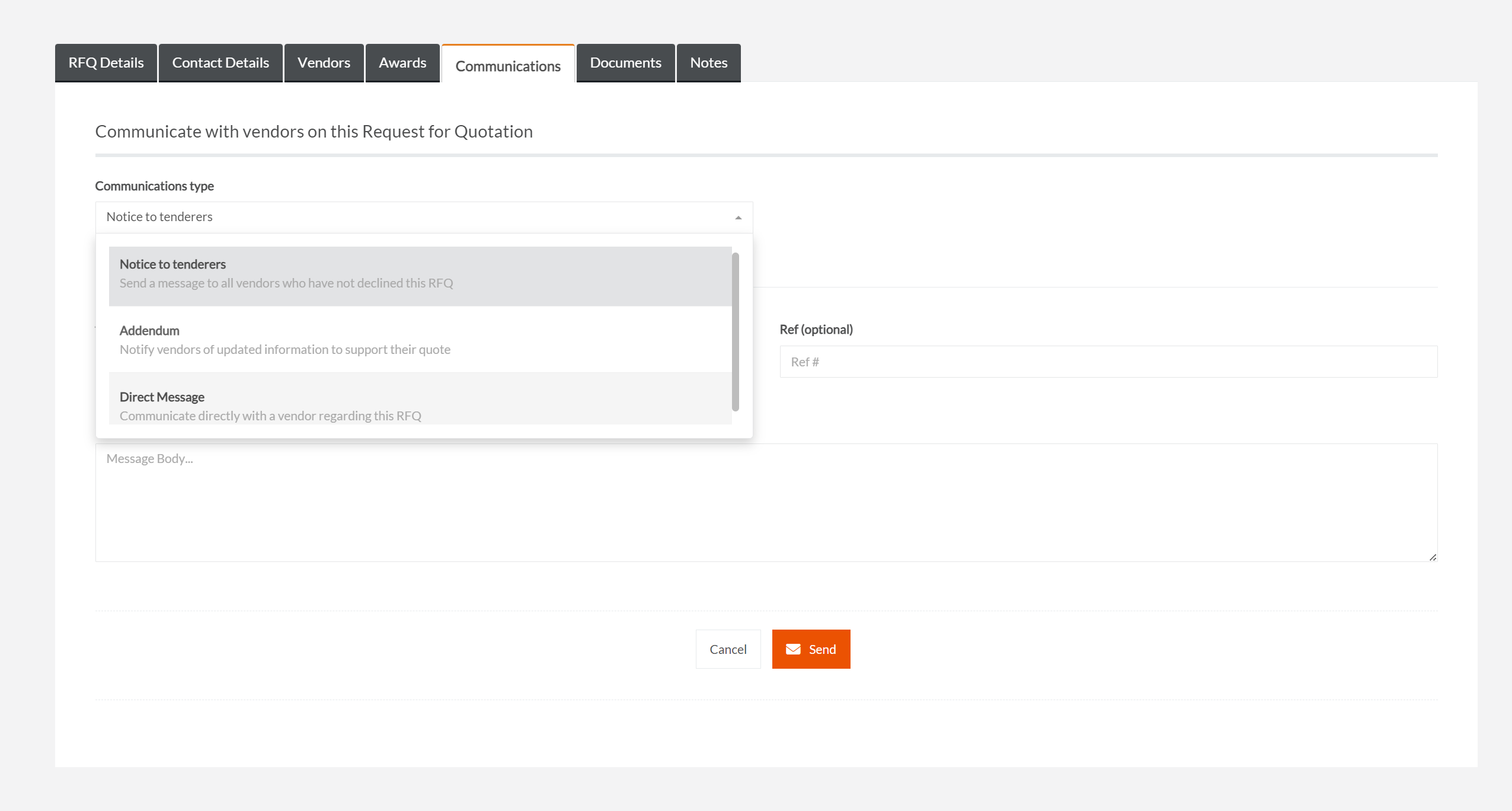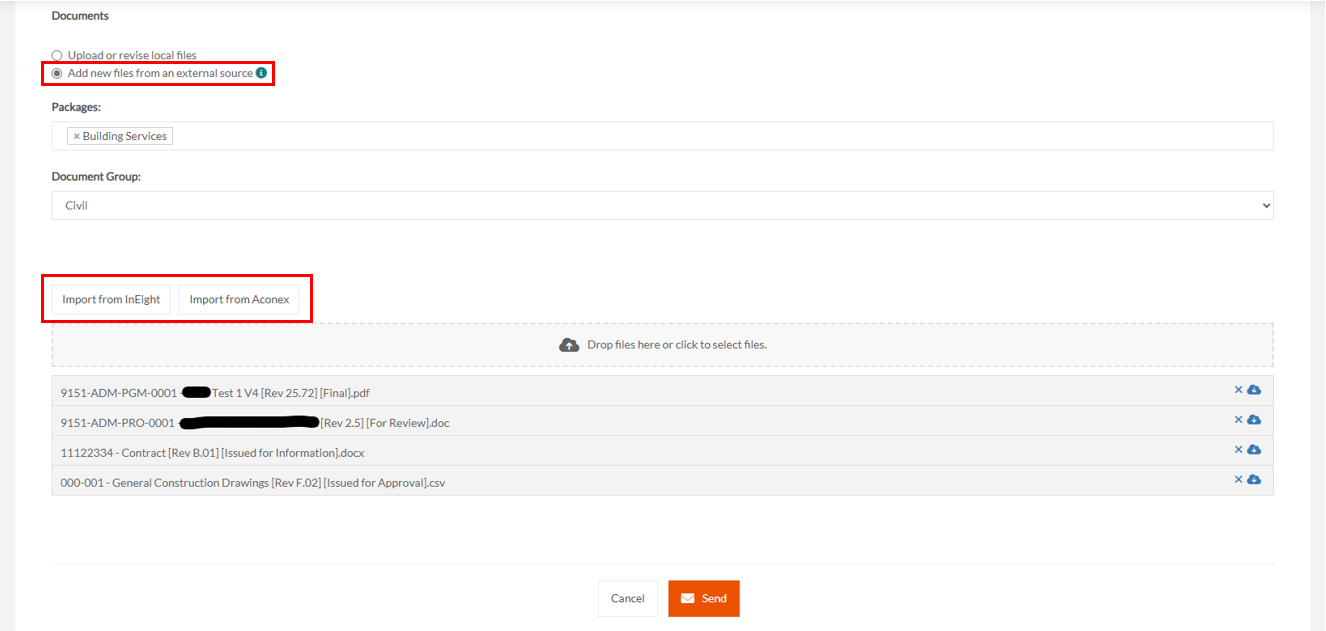Throughout the quoting period of an RFQ, you might want to communicate with your vendors, either directly (one-on-one) or by sending an addendum or tender notice to all vendors.
Post tender requests are also a form of communication in Closed RFQs. See this article for details specifically on the post tender request workflow.
TABLE OF CONTENTS
Vendors can have one or many users on their accounts. Communications on RFQs are delivered per their users' notification preferences, which each user can configure on their profile.
Sending a notice to all tenderers
A notice to all tenderers allows you to send a general update to all tenderers and does not require receipt acknowledgment by the vendor.
To send a notice to all tenderers:
- Navigate to Projects > Requests for Quotation from the main menu.
- Locate the RFQ for which you would like to send a notice to all tenderers by using the quick search or filters.
- Click on the RFQ Job Name or hover over the ellipsis icon and select View Details from the options.
- Go to the Communications tab.
- Click the New Message button.

- Select the Notice to all Tenderers communication type in the dropdown
- Update the following fields:
- (Required) Title - Enter a title for the message in the field provided.
- (Required) Body - Enter your message in the body field.
- (Optional) Ref # - Enter a reference number in the field provided.
- Click the Send button.

Sending an addendum (message, document or pricing schedule)
An addendum is a formal update to the RFQ which may include the distribution of:
- New or updated documents; and/or
- Updated written guidance in the form of a written message; and/or
- An updated pricing schedule version for vendors to complete pricing.
Addendums also prompt acknowledgment of receipt by the vendor.
If you intend to issue a new version of a pricing schedule in an addendum, you can create a draft ahead of time. See Editing and issuing a revision to a Pricing Schedule for more details.
To send an addendum to tenderers:
- Navigate to Projects > Requests for Quotation from the main menu.
- Locate the RFQ for which you would like to send an addendum by using the quick search or filters.
- Click on the RFQ Job Name or hover over the ellipsis icon and select View Details from the options.
- Go to the Communications tab.
- Click the New Message button.

- Select the Addendum communication type.
- Update the following fields:
- (Required) Title - Enter a title for the message in the field provided.
- (Required) Body - Enter your message in the body field.
- (Optional) Ref # - Enter a reference number in the field provided.

- On RFQ's where you have included a pricing schedule in Felix, you will also see a Pricing Schedule section in the Addendum form. Here you will be prompted to include a draft pricing schedule you may have prepared already - or to open a new page and prepare a draft pricing schedule to include.
Use the checkbox to include a draft pricing schedule with your addendum.
For more information on pricing schedule drafts and versions, see Editing and issuing a revision to a Pricing Schedule

- Next, its time to add any documents. There are two options to access and include documents - (1) Upload or revise local files or (2) Add new files from anexternal source.
- Upload or revise local files - Select this if you are uploading new files or issuing revised files from your computer or network drives. You can then attach them in the "drop zone" field. You can attach both new files and issue revised files in the same message.
Felix matches new file upload names with documents you have already released to vendors within the same RFQ. If the file name of the new upload is the same as one of the previously released documents, this attachment will be suggested as a revision of the matched document. In certain scenarios, a file may not be matched automatically. For example, the file name is significantly different from the original revision name. In this case, select the original document name from the dropdown.
- To upload new files:
- Attach the file in the drop zone field and select New Document (Not a Revision) from the dropdown.
- Select the relevant Group and Service from the dropdowns and click the Send button.

- To upload revised files,
- Attach the file in the dropzone link.
- Select the original document name from the dropdown and click the Send button.

- Add new files from an external source - Select this if you are uploading NEW files (not revisions) from a Document Management System (DMS) integration such as Aconex or InEight.
Upon selecting this, select the relevant Services and Document Group from the dropdowns. You will then be presented with a list of existing documents already imported from your DMS systems, as well as buttons to select additional documents from those systems.

For additional details on attaching external (DMS) documents from Aconex or InEight, refer to How to import Aconex documents or Import from InEight Document.
If you need to attach revised files (not new), you need to go to the Documents tab. Here you will have an option to select which revisions to include from your DMS, and an addendum will be triggered from there. For more detail, see Aconex document revisions or InEight document revisions.
- Click the Send button.
Confirming whether vendors have acknowledged your addendum
To view if a vendor has acknowledged an addendum you sent, navigate to the Communications tab, and select the relevant addendum from the list.
The status will show as Confirmed if the vendor has acknowledged receiving the addendum or Awaiting Confirmation if the vendor has yet to acknowledge the addendum.
Sending a direct message to one or more vendors
Sometimes on RFQs, you might need to directly communicate with a vendor or group of vendors independent of other vendors. An example might be that you've noticed an error with a vendor's submission and you'd like to let them know they need make an update. You can do this with a Direct Message, and you can include attachments.
To send a direct message:
- Navigate to Projects > Requests for Quotation from the main menu.
- Locate the RFQ for which you would like to send a notice to all tenderers by using the quick search or filters.
- Click on the RFQ Job Name or hover over the ellipsis icon and select View Details from the options.
- Go to the Communications tab.
- Click the New Message button.

- Select the Direct Message communication type in the dropdown
- Select one or more vendors from the Vendors select box. All vendors selected in the same communication will receive the same message and attachments.
- Update the following fields:
- (Required) Title - Enter a title for the message in the field provided.
- (Required) Body - Enter your message in the body field.
- (Optional) Ref # - Enter a reference number in the field provided.
- Add any attachments you need to include.
- Click the Send button.
Receiving correspondence from vendors
Vendors may send you a Request for Information ("RFI") in reply to any Notice to Tenderers or Addendum sent during the RFQ period, or they may send you a Direct Message.
The originator of the RFQ will receive email notification of correspondence from vendors.
To view and reply to RFQ correspondence from vendors:
- Navigate to Projects > Requests for Quotation from the main menu.
- Locate the RFQ you have received correspondence for by using the quick search or filters.
- Click on the RFQ Job Name or hover over the ellipsis icon and select View Details from the options.
- Go to the Communications tab.
- Locate the message you want to view and reply to by using the quick search or filters.
- Click the Title link of the RFI message to open it.
- Enter your Reply in the field provided.
- Click the Send button.

For RFIs - your replies will only be sent to the vendor who sent the RFI. If information you are replying with needs to be available to all vendors, it is best to use the Notice to all Tenderers or Addendum features.
READ MORE
Check out our blog post How Felix supports transparent vendor communication during tendering for tips on keeping vendors informed.









